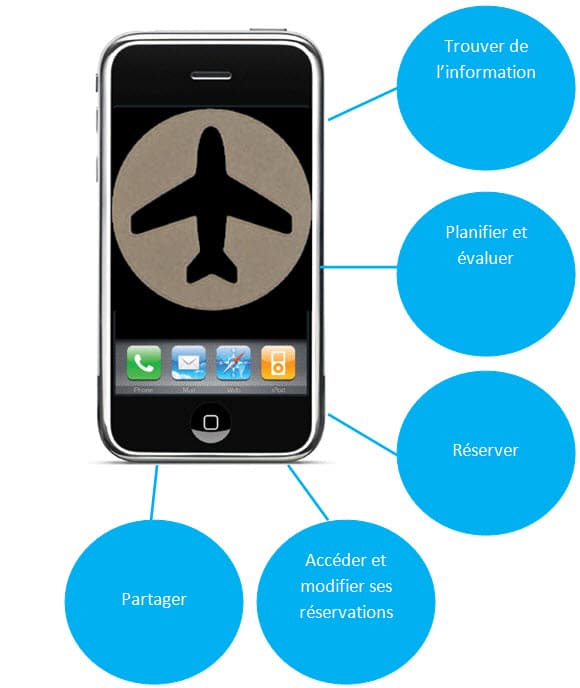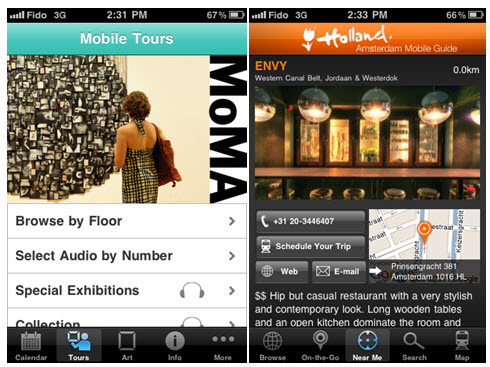Mobile strategy and tourism
Mobile, mobility, mobile applications, mobile websites, geolocation, augmented reality… so many words we hear about and on which we must bet big in 2011!
You decide to take the mobile turn, but there are still many questions to ask: Invest in a mobile version of your website or in a mobile application? On which platforms? My colleague Laurent has already done an excellent overview of the advantages and disadvantages of an application versus a mobile site in his series of App or not App? Long live mobile!
However, for this post, I will focus on the basics of a good mobile strategy. This mobile strategy, which will fit into the overall strategy of your tourism business, will make it possible to meet concrete business objectives and generate measurable results. Before determining which tools to choose, you must first start a strategic reflection, determine a mobile strategy and see how it will be integrated into the existing online strategy. Synergies must be created. How? That's what we're going to see.
THE RELEVANCE OF MOBILITY IN TOURISM
We talk a lot about mobility, but the sector of activity for which it is probably most relevant is tourism. Why? The trip takes the traveler to an unknown area where he needs information about his route, directions to a point, the best places to visit, communication with his social network, etc. The need for information is great and mobile meets this need. Smart phones are easy to carry, you always have them on you and they can provide quality information based on the location of the user. Thus, the 4 main objectives of the user on a mobile would be to:
- Find information: Wikitravel , Wikipedia , LonelyPlanet and online tourist guide apps
- Plan and Evaluate: Find information on attractions, events, hotels, restaurants, etc. nearby based on user reviews/ratings and personal interests
- Book: Make an online purchase of a tourist service directly on your smartphone ( HostelWorld , Hotels.com , Kayak , etc.)
- Access and modify reservations: Obtain online reservation confirmations (boarding pass, room reservation number, etc.) and modify/cancel a reservation
- Share: Share your travel experience in social networks ( Facebook , Twitter , Instagr.am , Trip Advisor , Yelp , etc.)
In addition, mobile can be used in all phases of online trip planning: before, during and after the trip. According to a study carried out by Ness , the tasks most coveted by travelers who use their mobiles are: seeing a map and getting directions to a place (35%), finding nearby activities (restaurants or shows for example – 28%), search for products such as a hotel room or a flight (25%), make an online purchase (21%), check in for a plane, hotel or train (20%), book accommodation (19%), make changes to reservations made (17%) and use the mobile as a boarding pass for a flight or train (16%).

BEFORE LEAVING: HAVE A CLEAR AND DETERMINED ONLINE AND OFFLINE STRATEGY
Before embarking on mobility, because it is the word that everyone has on their lips in the major trends of 2011, it is necessary first and foremost to have a clear online and offline strategy. Indeed, too many companies want to get into mobile without having first thought about their business objectives, their customers and how mobile could fit into their business strategy. You must first have a well-defined online and offline strategy that will guide the mobile strategy and that will be in synergy with what has already been developed.
THE 5 STEPS OF A MOBILE STRATEGY
1. UNDERSTAND
Before embarking on a mobile strategy, it is necessary to understand its business context, its users, its objectives, by asking the right questions. Here is a list of questions to help you get started:
- What are your business goals?
- What are your main markets for mobility? What are the priority levels for each of these markets?
- Who are your mobile customers? What are its needs, objectives to achieve and its behavior online, offline and mobile?
- In what contexts will she use her smart phone to interact with your company or institution? What will be his motivations?
- What is the added value that the user will seek on the mobile with your company or institution?
- How does the mobile app relate to internal business processes and internal company systems? Will the application need to be linked to an online reservation system, a payment system, a CRM, a database?
2. DETERMINE YOUR GOALS
It is also important to determine your business objectives and determine what your objectives will be in relation to your mobile strategy. Indeed, several objectives can be achieved. However, you have to ask yourself what the main and secondary objectives are and prioritize them. The strategy and tactics developed will be directly linked to your objectives :
- Acquire customers
- To win the loyalty of customers
- Increase the number of online reservations or purchases
- Support the user in his search for information and his comparison
- Etc.
3. DEFINE YOUR PERSONAS
Once your mobile strategy objectives have been well defined, you will need to define your personas, that is to say the users who will use your mobile website or your mobile application. There may be multiple personas depending on your potential mobile customer base. For example, it would be possible to find a “business traveler” persona and an “adventure traveler looking for the best price” persona.
Be careful, you should not fall into customer segmentation to determine personas: they are determined according to tasks and browsing behavior. Two visibly different customer segments can blend into the same persona if their tasks and browsing behaviors are the same.
Questions to ask:
- Who are the users of your mobile site or mobile application? What is their socio-demographic and psycho-graphic profile?
- What stage of travel planning will they be in (before, during or after the trip)?
- What will be its objectives to achieve?
- What tasks will he want to perform to accomplish his goals?
- What state of mind will they be in when using the mobile site or mobile application?
These personas will help guide the strategy and create use cases that will ensure that the mobile website or mobile application meets the needs of the users and allows them to perform each task that will meet their objectives.
4. REVIEW BEST PRACTICES AND MONITOR YOUR COMPETITORS
It is also relevant to make a comparative analysis of the mobile strategy of your competitors, of the tourism sector and why not, of other industries which have exemplary practices in mobile. Here are some interesting examples to point out in tourism:
- Destination app: Amsterdam
- Museums: MOMA New York with integrated audio guide by type of clientele
- Attractions: Gardens of Versailles and its augmented reality and audio guide
- Online travel guides: mTrip , Lonely Planet , etc.
- Transportation: Paris Metro, etc.

5. DETERMINE MOBILE STRATEGY
With all these ingredients combined, it will now be possible to determine the mobile strategy. Mobile app or mobile site? How will this mobile strategy be integrated with the current online and offline strategy? What features should be put forward? Do you have any other examples of inspiring tourism mobile strategy, mobile sites or mobile apps? Do not hesitate to share your impressions and comments!













